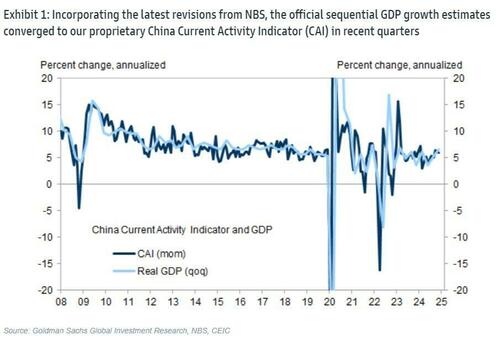By Stefan Koopman, Senior Macro Strategist at Rabobank
An Input, Not An Output
China just hit its 2024 growth target, as it always does. According to Bloomberg, an “11th-hour stimulus blitz” and “some export boom turbocharged activity” were required to get it over the line, but here we are. Gross domestic product rose 5.0%, exceeding forecasts of 4.9% growth. The December data showed a rapid rise in industrial production, up 6.2%, with some tentative signs that domestic demand is picking up as well. Retail sales rose 3.8% in the last quarter, its fastest pace in 2024. That said, its trade surplus surged to nearly $1 trillion last year – roughly the size of Poland’s entire economy. That means China needs the rest of the world for its growth; not the other way around.
Growth for 2025 is targeted at 5% again. Of course, we all pretend to forecast it as if it may not happen, but in China, GDP is an input, not an output. The global consensus among policymakers and analysts is that China will have to pivot from its export-dependent, investment-heavy growth model toward one centered on domestic consumption. Yet, this structural shift remains constrained by the ideological preferences of Chinese leadership, which continues to prioritize state-driven economic strategies. Even so, there are some indications of rebalancing. Money supply growth appears to be stabilizing, and after three consecutive years of contraction, the real estate sector may have bottomed. However, policy efforts to bolster consumer spending tend to underwhelm, contributing to uncertainty on how that 5% target will actually be achieved.
Meanwhile, in the U.S., economic data was mixed. Jobless claims edged slightly above expectations, while retail sales underwhelmed. However, control-group sales – the metric feeding directly into GDP – rose faster than forecast, contributing to a modest uptick in the Atlanta Fed’s Nowcast for Q4 GDP, which now projects a 3.0% annualized growth rate. Despite this, the data lacked the heft to prompt a significant market reaction, especially compared to Wednesday’s exuberance when both stocks and bonds rallied after a small beat in core inflation.
More notably, the Philly Fed survey surprised with a headline reading of 44.3, its highest since April 2021 and the largest positive surprise since 1998. This could reflect tariff-related front-loading activity, as such a surprise is otherwise hard to rationalize, but it may be mirrored in the January Manufacturing ISM.
Treasury yields eventually did fell another 2-4 basis points across the curve. This followed comments from the Fed’s Waller, who said the FOMC could lower rates more and sooner should inflation data continue to be favorable in the months ahead. His remarks threw a bit of cold water on the narrative that the Fed may be done cutting rates.
And then there was Trump’s Treasury pick, Scott Bessent, who had his hearing. He stated that the FOMC should remain independent, vowed to protect the USD’s status as the world’s reserve currency, loathed for China’s export-dependent growth model, advocated for ramping up sanctions on Russia, and pledged to work across the aisle to remove the debt ceiling if that’s what Trump wants. Additionally, he said he wants to prioritize extending the Tax Cuts and Jobs Act, while cutting the deficit by slashing discretionary spending.
